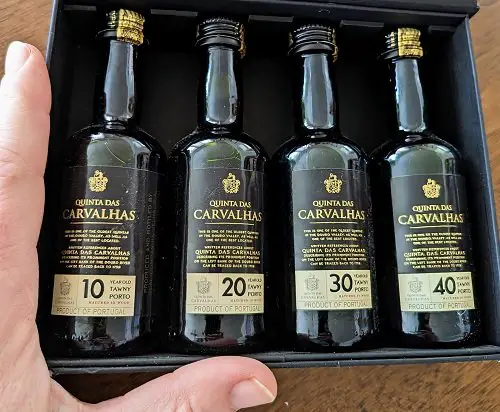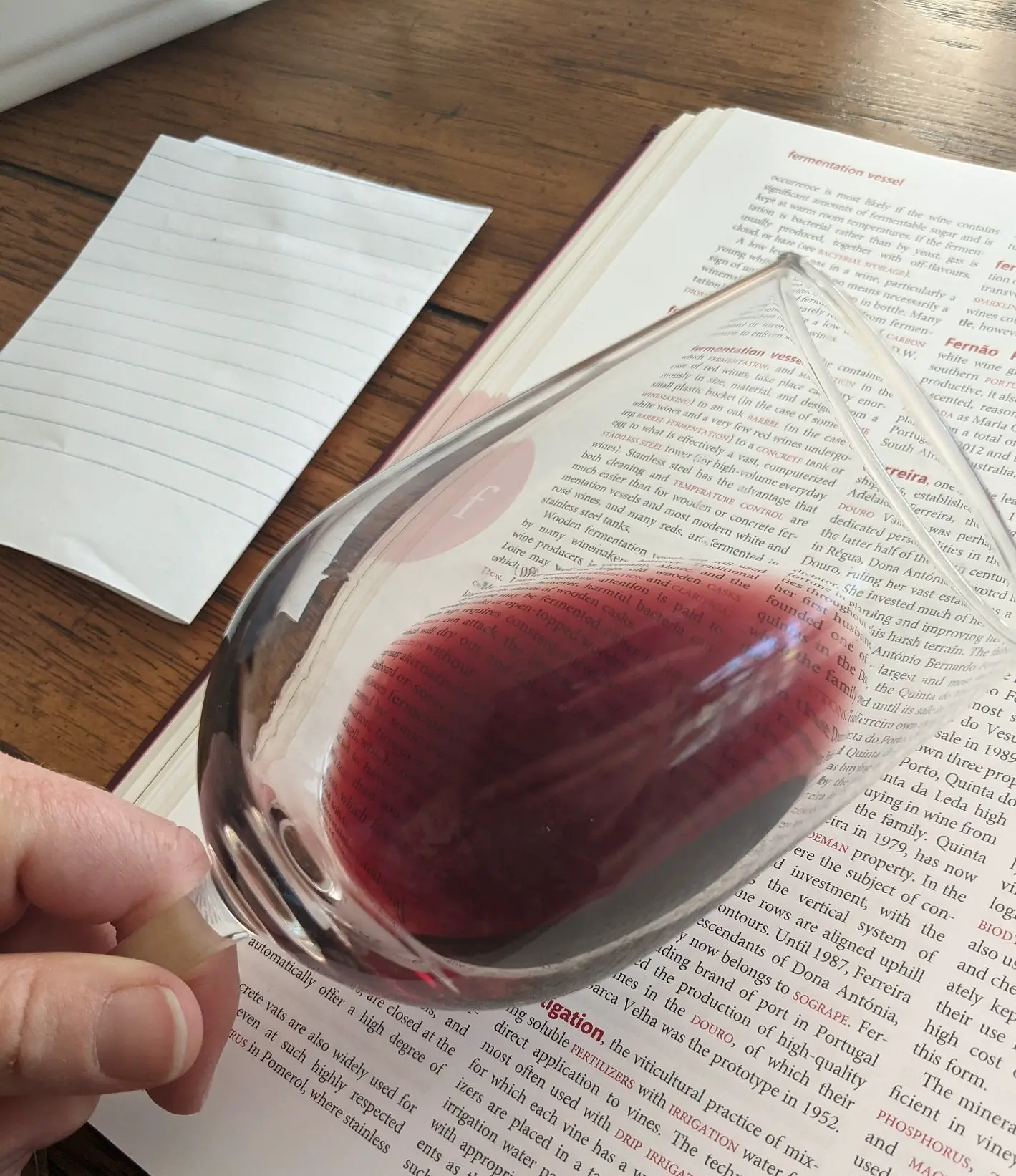
Port’s one of those wines that changes your life the first time you take a sip. Sweet, sweet nectar with a fiery bite.
Here’s a list of 16 common Port wine questions that cover the basics. I recommend pouring yourself a glass of Port and sipping along.
- Port Wine Question 1: Is Port Sweeter than Red Wine?
- Basics of Port Wine 2: Why Does Port Taste Sweet?
- Port Wine Basics 3: How Is Port Wine Different Than Regular Wine?
- Port Wine FAQ 4: Is Port Higher in Alcohol than Wine?
- Basics of Port Wine 5: What Are The Cons of Port Wine?
- Port Wine Basics 6: Is Port a Spirit or Liquor?
- Port Wine Question 7: Is Port Stronger than Wine?
- Basics of Port Wine 8: Does Port get you drunk?
- Port Wine Basics 9: Why Are Port Glasses Small?
- Port Wine Question 10: Can You Drink Port Straight?
- Basics of Port Wine 11: Can You Mix Port with Coke?
- Port Wine Question 12: Do You Drink Port Warm or Cold?
- Port Wine Basics 13: Why Is Port Called Tawny?
- Port Wine Basics 14: Is Port Wine Classy?
- Port Wine Basics 15: Can You Drink 40 Year Old Port?
- Port Wine FAQ 16: Does Port Get Better in the Bottle?
- Thirsty for More?
Port Wine Question 1: Is Port Sweeter than Red Wine?
Port is significantly sweeter than red wine. Port has 80 to 120 grams of sugar per liter. The average red table wine has under 3 grams per liter. Off-dry red wines with residual sugar tend to have under 15 grams of sugar per liter. Port is very sweet.
And Port wine is supposed to be sweet!
Basics of Port Wine 2: Why Does Port Taste Sweet?

Port tastes sweet thanks to unfermented grape juice. When grapes ferment into alcohol for regular wine, the yeast consume all of the sugar leaving behind dry table wines.
For Port, the winemaker stops fermentation when the alcohol level is around 7%, leaving behind unfermented grape juice.
There’s no added sugar in Port. Wine grapes are super sweet!
Helpful Post: Here’s a rundown on the differences between fortified and unfortified wines, which is useful as you get into fortified wines.
Port Wine Basics 3: How Is Port Wine Different Than Regular Wine?
Unlike regular wine, Port wines have spirit added to them during the winemaking process. This fortifies the Port, raising the alcohol to 19% and stops fermentation early, leaving the wine sweet. Regular wines have alcohol under 15% and are dry.
Port Wine FAQ 4: Is Port Higher in Alcohol than Wine?
Port is much higher in alcohol than wine, and has some of the highest alcohol levels in the wine world. A typical table wine has between 12%-15% abv. Port must be between 19%-22% abv per regulation. That’s a lot for a wine!
Basics of Port Wine 5: What Are The Cons of Port Wine?
Port wines are high in sugar and high in alcohol, making them a less healthy option than regular dry table wines.
Port Wine Basics 6: Is Port a Spirit or Liquor?
Technically, Port is a wine with spirit added during winemaking. Producers use 77% abv grape spirit. They can choose what style of spirit they want to use, which can influence the final style of wine. Fruity? Smooth? Inexpensive Ports may taste more spirity than some higher quality options.
Port Wine Question 7: Is Port Stronger than Wine?
Yes, Port is much stronger than wine. By regulation, Port must be between 19%-22% alcohol by volume. Most regular wines are 12%-15% abv. The alcohol in Port comes from grape fermentation and added spirit. The alcohol in wine only comes from the grapes.
Basics of Port Wine 8: Does Port get you drunk?
Oh my, yes! Port will get you drunk. This is a high alcohol fortified wine. A little goes a long ways. Start with small pours and sip slowly if you’re concerned about getting drunk off of Port wine.
Port Wine Basics 9: Why Are Port Glasses Small?
Traditional Port wine glasses are smaller because you typically enjoy a smaller pour of wine thanks to Port’s high alcohol content.
Helpful Tip: Here’s a rundown of what wine glasses you should be using when drinking Port wines (and also creative substitutes if you don’t have a full wine bar).
Port Wine Question 10: Can You Drink Port Straight?
Yes, you can drink Port straight. This is the most common way to enjoy Port wines. Chill it slightly in the fridge for 30 minutes before pouring. Add a brownie or a chocolate chip cookie on the side and you’re in for a treat!
Personal Testimonial: I drink my Port straight.
Basics of Port Wine 11: Can You Mix Port with Coke?
A classic mixed drink is Port with Coke. Mix 1 part Port with 2 parts Coke and pour over ice. Need another variation on Port and Coke? Try Port with Sprite (lemon/lime soda) for an adult Shirly Temple.
Port Wine Question 12: Do You Drink Port Warm or Cold?
Drink your Port slightly chilled. Put it in the refrigerator 30 minutes before serving.
Port Wine Basics 13: Why Is Port Called Tawny?
Tawny Port is one style of Port. Tawny Ports get their name from their tawny red-brown color that comes from aging. Tawny Ports have caramel and nutty flavors. Not all Ports are Tawny Ports. Ruby Port is another popular style of Port wine.
Port Wine Basics 14: Is Port Wine Classy?
Port wine is classy! Port gained popularity in the 1600s thanks to favorable trading agreements between Portugal and England. The merchant classes popularized the wine’s style with the upper class. Today, Port makes the perfect after dinner drink for all wine lovers.
Port Wine Basics 15: Can You Drink 40 Year Old Port?

Yes, you can drink 40 year old Port wines. Port wines can have a very long life thanks to high alcohol and intense flavors, but not all Ports are made to age.
Basic Ruby and Tawny Ports should be enjoyed when you buy them, but if you hold on to them for 40 years, it won’t hurt you to take a sip!
Vintage Ports are made for aging and can withstand decades in the bottle.
You’ll pay a premium for Vintage Port wines, but they can last! Many wine lovers buy these special bottles for their children and grandchildren to enjoy when they’re born to celebrate when they reach maturity!
Don’t want to wait for decades to enjoy your Port wines?
Look for age-indicated Tawny Ports, like 10-, 15-, and 20-year-old Tawny Ports. These wines are specially crafted from a blend of aged Port wines back at the winery so that they have the flavor profile of well-developed Ports.
Full Disclosure: I love Tawny Ports. They’re some of my absolute favorite fortified wines. (Okay, Amontillado Sherry also holds a special place in my heart… and wine cellar, too. So many options!)
Port Wine FAQ 16: Does Port Get Better in the Bottle?
Most styles of Port won’t get better in bottle. Port’s high alcohol and tannin act as preservatives, but once bottled, it isn’t going to get any better. Exceptions are Colheita Port, Vintage Port, and Crusted Ports; all can develop intoxicating complexity with time (and the price reflects this).
Thirsty for More?

So much goes into Port winemaking, so I put together this post that covers how Port is made from beginning to bottle.
To explore more about the history and styles of Port wine, check out the Port Institute that regulates Port wine production (external link).
Interested in different Port styles?
Here are a few worthy of your time:
Late Bottled Vintage Port
A Quick Guide to Ruby Port
Differences Between Port & Tawny Port





